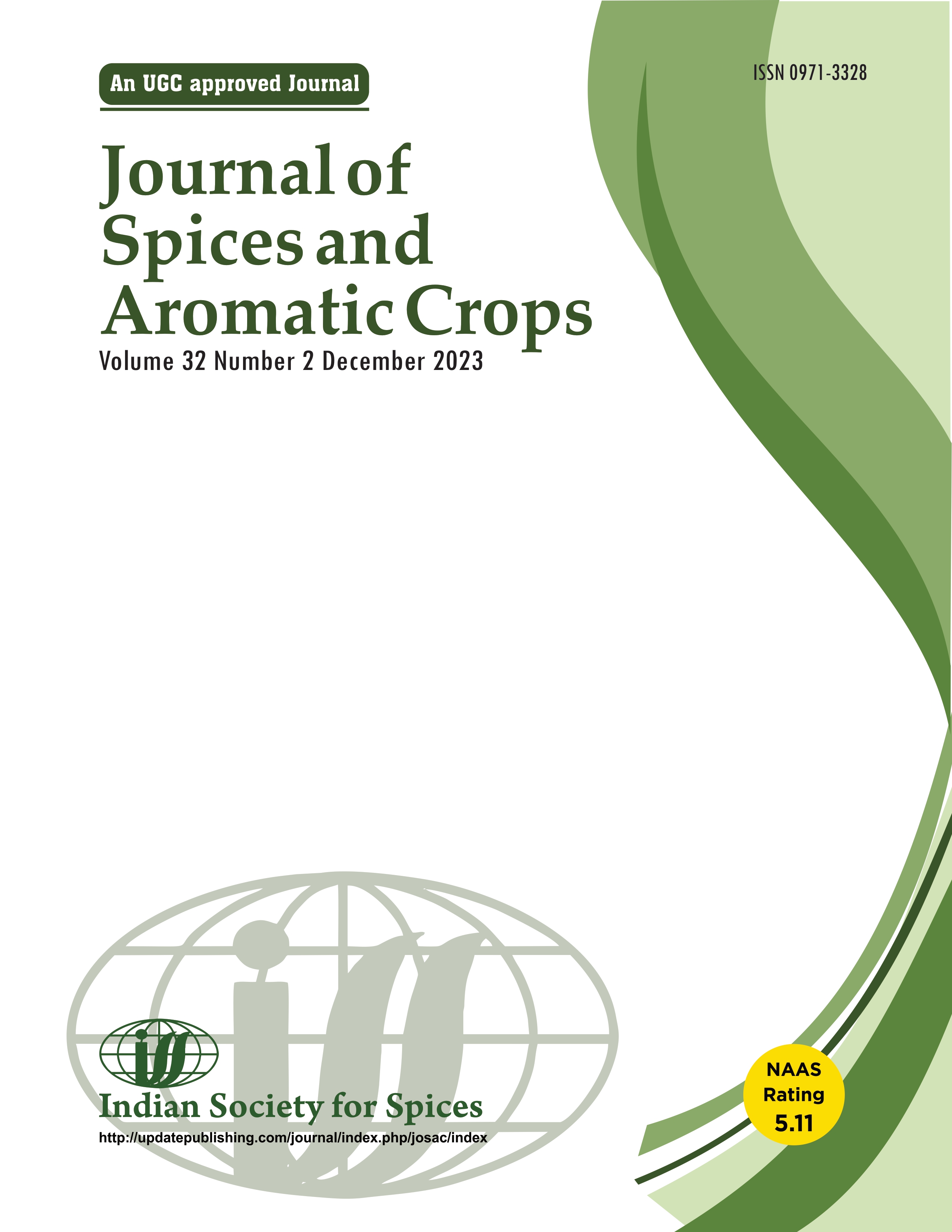Ajwain (Trachyspermum ammi L. Sprague) based intercropping for higher system productivity of semiarid tropics of Northern Karnataka
Ajwain based intercropping
DOI:
https://doi.org/10.25081/josac.2023.v32.i2.8874Keywords:
Ajwain, intercropping, leafy vegetables, oil content, B:C ratio, Land Equivalent Ratio (LER) and Ajwain Equivalent Yield (AEY)Abstract
Field trials were executed at the University of Horticultural Sciences, Bagalkot, Karnataka during the kharif season of 2016 and 2017 to study the growth and productivity of ajwain and leafy vegetables under intercropping system including economic profitability of such cropping systems in Northern Karnataka. The experiments were carried out with thirteen treatments comprising sole ajwain and sole crops of leafy vegetables (fenugreek, coriander, dill and amaranthus) and various combinations of ajwain and leafy vegetables in 1:1 and 1:2 ratios adopting randomized complete block design with three replications. Results showed that the sole crop of ajwain exhibited superior growth and yield. However, in intercropping systems, the combination of ajwain and coriander at a 1:1 ratio demonstrated the highest growth and yield parameters. The sole crop of ajwain recorded the maximum plant height (84.64 and 84.55 cm), number of branches per plant (52.38 and 52.19), number of umbels per plant (166.54 and 164.93), number of umbellate per umbel (12.44 and 12.34), and seed yield (12.95, 12.88 q ha-1 during both the years, respectively). This performance was comparable to intercropping with ajwain + coriander (1:1). Sole crops of fenugreek, coriander, dill, and amaranthus yielded higher fresh market yields compared to different intercropping systems. Notably, growing ajwain as an intercrop with coriander at a (1:1) resulted in a significantly higher land equivalent ratio (1.61) and a higher benefit–cost ratio (2.99) followed by ajwain + fenugreek (1:1) (2.98).
Downloads
References
Anonymous, 2020 Directorate of Arecanut and Spices Development (DASD). Govt. of India.
Islam M R, Rahman M T, Hossain M F & Ara N 2014 Feasibility of intercropping leafy vegetables and legumes with brinjal, Bangladesh. J. Agric. Res. 39(4): 685–692.
Mehta R S, Meena S S & Anwer M M 2010 Performance of coriander (Coriandrum sativum L.) based intercropping system. Indian J. Agron. 55(4): 286–289.
Mehta R S, Singh B, Meena S S, Lal G, Singh R & Aishwath O P 2015 Fennel (Foeniculum vulgare Mill.) based intercropping for higher system productivity. Int. J. Seed Spices. 5(1): 56–62.
Rahman M, Rahman M H, Haque M E & Naber K S 2006 Banana–based intercropping system in northern port of Bangladesh. J. Agron. 5(2): 228–231.
Sakala W D, Cadisch G & Giller K E 2000 Interactions between residues of maize and pigeon pea and mineral nitrogen fertilizer during decomposition and nitrogen mineralization. Soil Biol. Biochem. 32: 699–706.
Tiwari R S, Agarwal A & Sengar S C 2002 Effect of intercropping on yield and economics of fennel (Foeniculum vulgare Mill.). Crop Res. 23 (2): 369–374.
Published
How to Cite
Issue
Section
Copyright (c) 2023 Honnappa Asangi, K N Kattimani, A B Mastiholi, R Siddappa, C B Harisha

This work is licensed under a Creative Commons Attribution-NonCommercial-NoDerivatives 4.0 International License.






 .
.